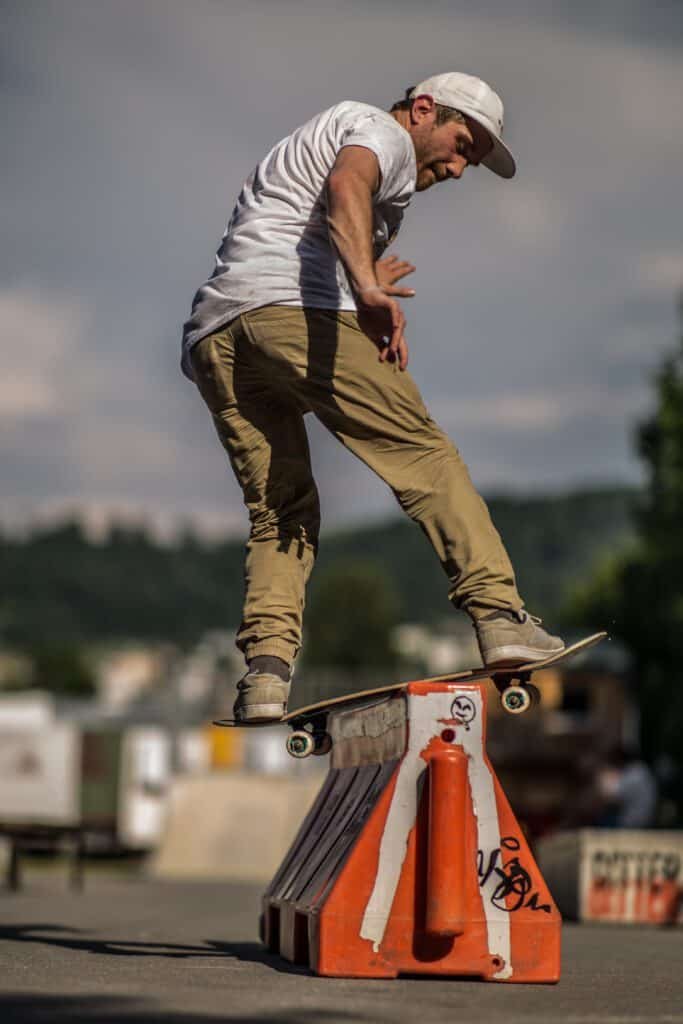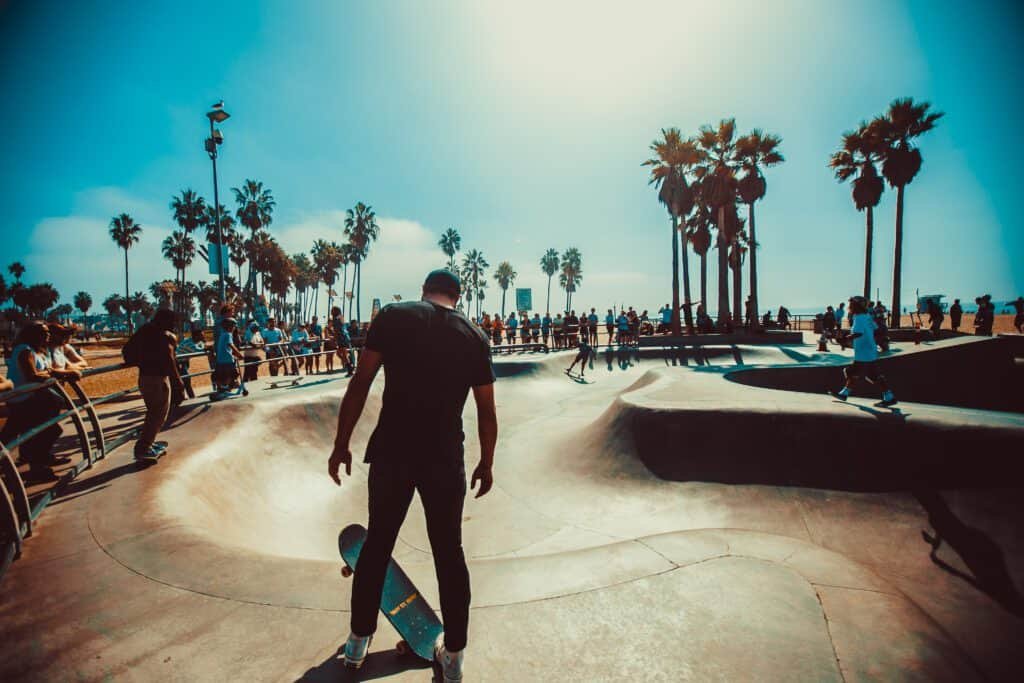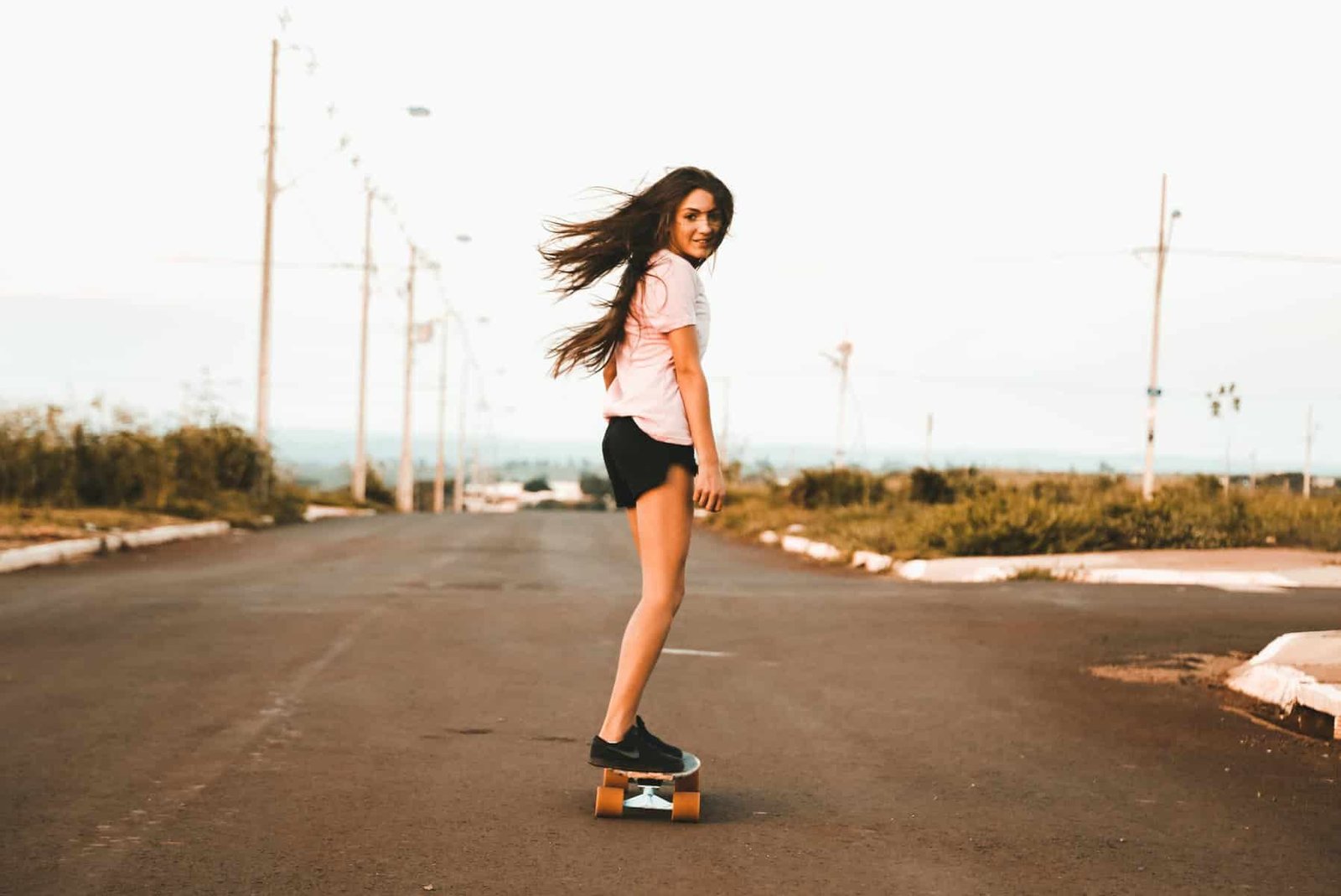Have you ever wondered how to improve your pushing and cruising skills on a skateboard? Whether you’re a beginner or a seasoned skater, mastering these fundamental techniques is key to navigating the streets with grace and style. In this article, we’ll explore some effective tips and exercises that will help you enhance your pushing and cruising abilities, allowing you to glide effortlessly and confidently on your skateboard. So get ready to embrace the pavement and take your skateboarding skills to new heights!

Choosing the Right Skateboard
When it comes to skateboarding, one of the first steps in getting started is choosing the right skateboard for you. This involves considering various factors such as the size of the skateboard, the type of deck, the wheel hardness, and the truck size. By taking the time to carefully select the right components, you can ensure a more enjoyable and comfortable skateboarding experience.
Selecting the Right Skateboard Size
One of the most important factors to consider when choosing a skateboard is the size. Skateboard sizes are typically measured in width, ranging from around 7.5 inches to 8.5+ inches. The right size for you depends on your personal preference and skating style. If you’re a beginner or enjoy doing tricks and flips, a smaller skateboard in the 7.5 to 8.0-inch range may be suitable. On the other hand, if you’re more into cruising or vert skating, a larger skateboard in the 8.0-inch and above range may provide more stability and control.
Choosing the Right Skateboard Deck
Another crucial aspect of choosing the right skateboard is selecting the appropriate deck. Skateboard decks are typically made from either maple wood or composite materials. Maple wood is known for its durability and pop, making it an excellent choice for most skaters. Composite decks, on the other hand, are lighter and more flexible, ideal for those interested in technical skating and street tricks. Consider your skating style and preferences when deciding on the deck material.
Selecting the Right Wheel Hardness
The hardness of skateboard wheels is measured on a durometer scale. For street and park skating, harder wheels within the 99A to 101A range are commonly used. These wheels provide less grip, allowing for easier slides and tricks. On the other hand, if you’re more into cruising and want a smoother ride, softer wheels in the 78A to 87A range are more suitable. These wheels offer better shock absorption and grip, making them ideal for rougher terrain.
Choosing the Right Truck Size
Trucks are the metal T-shaped components that attach the wheels to the skateboard deck. They come in various sizes, typically measured by the width of the hanger. The size of the truck you choose should match the width of your skateboard deck. A general rule of thumb is that the axle width of the trucks should be similar to the width of your skateboard deck. This ensures optimal stability and control while riding.
Pushing Techniques
Once you have chosen the right skateboard, it’s time to learn and practice pushing techniques. Pushing is an essential skill that allows you to gain speed and move around on your skateboard. There are different pushing techniques you can try based on your preference.
Regular Pushing
Regular pushing is the traditional method of pushing on a skateboard. Place your front foot on the skateboard deck, slightly angled toward the nose. Place your back foot on the ground and push off, transferring your weight onto your front foot as you gain speed. As you push with your back foot, make sure to maintain a stable and balanced posture. This technique is commonly used by skaters with their left foot forward (regular stance).
Mongo Pushing
Mongo pushing, although considered less common, is another pushing technique you can try. With mongo pushing, you push off with your front foot while keeping your back foot on the skateboard deck. This technique is commonly used by skaters with their right foot forward (goofy stance). While mongo pushing may feel more comfortable for some, it’s important to note that it can be less efficient and less stable compared to regular pushing.
Pumping for Speed
Pumping is a technique used to generate speed without pushing off with your feet. It involves using your body to transfer weight back and forth, creating momentum. To pump for speed, start by bending your knees and shifting your weight to the front as you go down a slope or into a transition. As you reach the bottom, extend your legs and shift your weight backward, pushing against the transition or the ground. This motion helps propel you forward, allowing you to maintain or gain speed.
Cruising Techniques
Cruising on a skateboard is all about enjoying the ride and maintaining control. To cruise effectively, there are a few techniques you can practice to enhance your stability and maneuverability.
Balancing on the Board
The key to successful cruising is finding and maintaining your balance on the skateboard. Stand with your feet shoulder-width apart and relax your body. Keep your knees slightly bent and distribute your weight evenly between both feet. Engage your core for stability and try to keep your upper body centered. Balancing on the board may take some practice, but with time, it will become second nature.
Foot Placement for Stability
Placing your feet correctly on the skateboard is essential for stability while cruising. Position your front foot at a slight angle, with the toes slightly hanging off the board’s edge. This positioning provides better control and maneuverability. Place your back foot on the skateboard’s tail, near the edge but with the toes pointed toward the center of the board. Having your back foot in this position helps with turning and stability.
Maintaining Proper Posture
Maintaining proper posture is crucial for cruising on a skateboard. Keep your back straight and your head up, looking forward. Relax your shoulders and avoid slouching or leaning too far forward or backward. Maintaining a balanced and upright posture not only helps with stability but also prevents strain and fatigue.
Carving for Smooth Turns
Carving is a technique that allows you to make smooth turns while cruising. To carve, shift your weight from the heelside (turning left) to the toeside (turning right) of the skateboard while leaning and pushing gently with your toes and heels. This motion initiates the turn, and by bending your knees and following through with your body, you can maintain a fluid and controlled carve. Practice carving on open paths or wide spaces to get the hang of it and improve your cruising experience.
Improving Balance and Coordination
To become a proficient skateboarder, it’s important to work on improving your balance and coordination. These skills will help you execute tricks, maintain control, and progress in your skateboarding journey.
Practicing Standing on One Foot
A great way to develop balance and coordination is by practicing standing on one foot. Start by standing on your skateboard with both feet parallel to each other. Lift one foot off the board and try to balance on the other foot. As you get more comfortable, challenge yourself by bending your standing leg or closing your eyes. Aim to hold your balance for as long as possible before switching to the other foot. This exercise strengthens your core and stabilizer muscles, which are essential for skateboarding.
Performing Tic Tacs
Tic tacs are small rocking motions you can perform on your skateboard to improve your balance and coordination. Start by standing with your feet parallel to each other on the skateboard. Shift your weight to one side of the board, lifting the opposite wheels slightly off the ground. Rock back and forth, mimicking a pendulum motion with your body. As you gain confidence, try to perform larger tic tacs, utilizing your hips and shoulders for more exaggerated movements.
Attempting Manuals
Manuals are tricks that require excellent balance and coordination. They involve lifting the front or back wheels of the skateboard off the ground while riding on two wheels. To practice manuals, start by finding a smooth and open space. Begin riding at a comfortable speed and transfer your weight to the back or front foot, depending on which manual you want to attempt. As you shift your weight, keep your body centered over the two wheels and maintain a steady balance. With practice, you’ll be able to hold manuals for longer periods and incorporate them into your skateboarding style.

Building Leg Strength
Skateboarding requires significant leg strength and power. To improve your performance on the board, it’s important to incorporate leg-strengthening exercises into your training routine.
Doing Squats and Lunges
Squats and lunges are excellent exercises for building leg strength, particularly in the quadriceps, hamstrings, and glutes. Start with squats by standing with your feet shoulder-width apart. Bend your knees and lower your body as if sitting back into a chair. Keep your chest up and your back straight. Push through your heels to return to the starting position. Lunges are performed by stepping forward with one leg and lowering your body until both knees are at 90-degree angles. Push back through the heel of your front foot to return to standing position. Incorporate squats and lunges into your workout routine to strengthen the muscles used in skateboarding.
Practicing Board Steps and Jumps
Board steps and jumps are exercises that simulate the movements involved in skateboarding. Find a stable surface, such as a low step or a curb. Place your skateboard on the edge, ensuring it’s secure. Practice stepping on and off the board, alternating between your feet. As you become more comfortable, try adding a small hop or jump onto the board. These exercises help develop leg strength, balance, and coordination, preparing you for various skateboarding techniques.
Performing Calf Raises
Calf raises are beneficial for strengthening the calf muscles, which play a crucial role in skateboarding. Stand with the balls of your feet on the edge of a step or a curb, allowing your heels to hang off. Slowly raise your heels as high as possible, then lower them back down. Repeat this movement for a set number of repetitions or until fatigue. Calf raises can be done as bodyweight exercises or with added resistance, such as holding dumbbells or using a calf raise machine at the gym.
Mastering Stopping Techniques
Being able to stop effectively on a skateboard is vital for safety and control. There are several stopping techniques you can practice to enhance your skill and confidence.
Practicing Foot Braking
Foot braking is a basic stopping technique that involves dragging your back foot on the ground to slow down and eventually stop. To foot brake, shift your weight to your back foot and gently press the sole of your shoe against the ground. Increase the pressure gradually until you slow down or come to a complete stop. Start practicing foot braking on smooth and flat surfaces, gradually progressing to inclines as you become more comfortable.
Mastering Power Slides
Power slides are an advanced stopping technique that involves sliding the wheels of your skateboard sideways to decrease speed rapidly. To perform a power slide, shift your weight toward the back of the board and turn your shoulders and hips in the direction you want to slide. Apply pressure to the tail of the skateboard and use your front foot to gently guide the slide. It’s important to practice power slides in controlled environments with plenty of space and minimal traffic to avoid accidents.
Learning How to Use a Tail Stop
A tail stop is a stopping technique primarily used for emergencies or situations where quick stopping is required. To perform a tail stop, shift your weight toward the back of the skateboard and place your back foot on or slightly behind the tail. Apply downward pressure to the tail, pressing it against the ground to create friction and slow down. The tail stop can be useful when you need to stop abruptly, but it’s important to use caution and not rely solely on this technique for everyday stopping.

Navigating Obstacles
To truly enjoy skateboarding, you need to have the skills to navigate obstacles confidently. Learning various turning techniques and developing the ability to perform kick turns and ollies over small obstacles will open up new possibilities in your skateboarding journey.
Practicing Turning Techniques
Turning techniques are essential for maneuvering around obstacles and changing direction. The basic turning technique involves shifting your weight and leaning in the direction you want to turn. Start by bending your knees and slightly lean your body while keeping your shoulders parallel to the board. As you turn, focus on leaning with your whole body and using your arms to maintain balance. Practice turning on flat ground before progressing to more challenging terrains.
Mastering Kick Turns
Kick turns are essential for executing sharp turns and navigating curbs or other obstacles. To perform a kick turn, shift your weight toward your toes as you approach the obstacle. Use your back foot to kick the tail of the skateboard downwards, lifting the front wheels off the ground. Simultaneously turn your upper body and shoulders in the direction you want to go. As the front wheels clear the obstacle, use your front foot to guide the skateboard and complete the turn. Mastering kick turns will greatly enhance your ability to navigate tight spaces.
Learning How to Ollie over Small Obstacles
The ollie is one of the most fundamental tricks in skateboarding and involves jumping with your skateboard to clear obstacles. To learn how to ollie, start by positioning your feet in the ollie stance, with your back foot on the tail and your front foot slightly behind the front bolts. As you roll toward the obstacle, pop the tail of the skateboard down while simultaneously dragging your front foot up the grip tape. This motion will create a pop and lift the skateboard off the ground. Slide your front foot forward, leveling out the board in the air, and aim to clear the obstacle. Ollies require practice and timing, so start with smaller objects before progressing to larger ones.
Developing Speed Control
Being able to control your speed is crucial for skateboarders to navigate different terrains and perform tricks safely. Mastering speed control techniques will not only make you a more confident skater but also allow you to explore different aspects of the sport.
Practicing Speed Control on Different Terrain
To develop speed control skills, it’s important to practice on various terrains and surfaces. Start with smooth and flat ground to get a feel for how your skateboard reacts to speed. Experiment with shifting your weight, applying pressure to different parts of the board, and adjusting your body position to control your speed. As you become more comfortable, gradually progress to inclines and different surfaces like skate parks or ramps. Understanding how your skateboard behaves in different situations will enable you to maintain control and stay safe while skating.
Learning How to Pump for Speed
Pumping is a technique that allows you to generate speed without relying solely on pushing. It involves using your body to maintain momentum by shifting your weight back and forth. To pump for speed, start by bending your knees and shifting your weight to the front as you go down a slope or transition. As you reach the bottom, extend your legs and shift your weight backward, pushing against the ground or transition. This motion generates energy, which is transferred to the skateboard, propelling you forward. Practice pumping on ramps or transitions, gradually increasing your speed and refining your technique.
Safety Tips
Skateboarding is an exciting and fun activity, but it’s important to prioritize safety. By following these safety tips, you can minimize the risk of injury and enjoy skateboarding to the fullest.
Wearing Proper Safety Gear
When skateboarding, always prioritize safety by wearing the appropriate protective gear. This includes a properly-fitted helmet, elbow pads, knee pads, and wrist guards. These protective measures can significantly reduce the risk of head injuries, fractures, and scrapes. Additionally, wearing skate shoes with good grip and ankle support will provide better control and protection while riding.
Finding Suitable Skateboarding Areas
Choose suitable areas for skateboarding to ensure a safe and enjoyable experience. Look for skate parks, designated skateboarding areas, or smooth, even surfaces free of pedestrians and traffic. Avoid areas with uneven terrain, cracks, or debris that could cause accidents. Skateboarding in designated areas reduces the risk of colliding with pedestrians, vehicles, or obstacles, making it safer for all parties involved.
Being Aware of Surroundings
Always be aware of your surroundings when skateboarding. Pay attention to pedestrians, cars, and other obstacles that may unexpectedly appear. Make eye contact with drivers when crossing streets and use hand signals to communicate your intentions. Skate within designated skateboarding areas and respect the rules and regulations of the environment you’re in. By staying aware and alert, you can avoid potential accidents and keep yourself and others safe.
Progressing to Advanced Skills
Once you have built a strong foundation and mastered the basics, you can start exploring advanced skateboarding skills and tricks. Here are a few areas you can focus on to take your skateboarding to the next level.
Learning Tricks: Ollies, Kickflips, and Shuv-its
Learning tricks is an exciting part of skateboarding and allows you to express your creativity and style. Focus on mastering fundamental tricks such as ollies, kickflips, and shuv-its. Ollies are the foundation for many tricks and involve jumping with your skateboard. Kickflips add a spinning motion to the ollie, flipping the board as you jump. Shuv-its involve spinning the board with your foot while jumping. Progressing to advanced tricks requires practice, patience, and dedication.
Exploring Different Skateboarding Styles
Skateboarding offers a wide range of styles and disciplines to explore. From street skating to vert skating, freestyle, and downhill, each style offers unique challenges and opportunities for growth. Experiment with different terrains, ramps, and obstacles to find your preferred style. Develop your skills in your chosen discipline by studying professional skateboarders and learning from their techniques. As you explore different styles, you’ll discover new ways to push your limits and continuously improve.
In conclusion, skateboarding is an exciting and diverse sport that offers endless possibilities for growth and enjoyment. By choosing the right skateboard and components, practicing pushing and cruising techniques, improving balance and coordination, building leg strength, mastering stopping techniques, navigating obstacles, developing speed control, prioritizing safety, and progressing to advanced skills, you can embark on a fulfilling skateboarding journey. Remember to have fun, stay committed, and always prioritize safety. Enjoy the ride!

